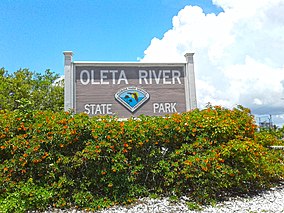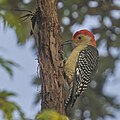This article needs additional citations for
verification. (September 2015) |
| Oleta River State Park | |
|---|---|
IUCN category IV (habitat/species management area) | |
 Entrance sign to Oleta River State Park | |
| Location | North Miami Beach, Miami, Florida, United States |
| Coordinates | 25°55′08″N 80°08′24″W / 25.91889°N 80.14000°W |
| Area | 1,043 acres (4.22 km2) |
| Created | 1986 |
| Governing body | Florida State Parks |
| Website | Oleta River State Park |
The Oleta River State Park is a 1,033-acre (418 ha) state park on Biscayne Bay in the municipal suburb of North Miami Beach in metropolitan Miami, Florida. Adjoining the Biscayne Bay Campus of Florida International University, the park contains one of the largest concentrations of Casuarina trees (Australian 'pine'), an invasive species in the state park system. Along the park's coastline are mangrove forests. They provide vital nurseries for aquatic life and filter urban pollutants from coastal waters. The state park promotes biodiversity of flora and fauna through the assistance of Friends of Oleta River State Park. The 501(c)(3) nonprofit citizen support organization (CSO); sponsors events, raises funds, and advances the goals of Oleta River State Park. The state park hosts about 15 endangered species.
Facilities
The central feature of this park is the mouth of the Oleta River, for which it is named. The river has drawn human inhabitants to the area since about 500 B.C, when its shores served as a campground for Tequesta Indians. It was used by U.S. troops (who called it Big Snake Creek) in 1841 during the Second Seminole War, and further explored in 1881 by Naval Captain William Hawkins Fulford, whose ventured inland to what is now the city of North Miami Beach. The area became more heavily settled in the 1890s and in 1922, developers changed the name from Big Snake Creek to the Oleta River.
The river itself no longer flows to the Everglades, but remains a popular area for canoeing. The park also boasts some of the best wilderness bike trails in the country and is a frequent host for triathlons and other extreme sports events. There is a beach on Biscayne Bay, kayak rentals, and primitive cabins. A Florida State Parks Annual Pass allows unlimited entrance into any of the state parks. Oleta River State Park is also the headquarters to one of the state's five AmeriCorps Florida State Parks chapters. The state park welcomes approximately 25 million visitors annually.
Health concerns
Oleta River State Park is adjacent to Munisport landfill, a former superfund site. However, no health issues at Oleta River State Park have been linked to the landfill. [1] There are four water treatment plants nearby the state park. The nearest wastewater treatment plant is the North District Wastewater Treatment Plant, which handles their wastewater and others nearby.
Gallery
-
Path to beach
-
Picnic area by beach
-
Picnic area and pier
-
Picnic area and paths
-
Cocoplum growing in Oleta River State Park - Fruit and branches
-
Detail of branches
-
Mature and immature fruits
-
Marsh and Mangroves
-
Mangroves
-
Sabal Palm growing in the park
-
Wild Lantana flowers growing
-
Wild lantana growing near road leading to entrance to park
-
General view of beach
-
Underview of bridge leading to the park
-
View of barrier underneath bridge to protect pilons
-
View of water with sediments and oyster beds underneath Oleta River bridge
-
Mangrove forest
-
Zebra longwing butterfly
-
White checkered butterfly
-
Female cardinal
-
Red-bellied woodpecker
-
Mockingbird
-
Grackle
-
Dolphin
-
Manatee
See also
External links
- Oleta River State Park at Florida State Parks
- Oleta River State Recreation Area at Absolutely Florida
- Oleta River State Recreation Area at Wildernet
- Oleta River State Park Mountain Bike Trail at Dirtworld.com
References
- ^ "Public Health Assessment, Munisport Landfill, North Miami, Dade County, Florida". Archived from the original on September 29, 2000. Retrieved July 28, 2007.

























